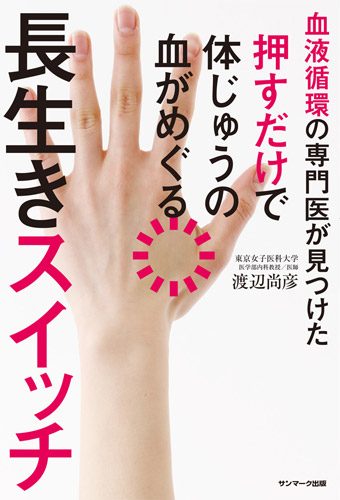


ISBN978-4-7631-3623-7 C0036
159 pages / Jyly 2017 / 1,300 yen (w/o tax)
This 5-minute method for improving blood flow will eliminate a variety of conditions such as high blood pressure, frozen shoulder, depression and dizziness!
We know that blood flow is an extremely important part of good health. We also know that exercise helps increase blood flow. But exercising can be difficult for various reasons such as injury, illness or a lack of time. The good news is that there’s a spot on our hand that acts as a switch that instantly improves blood flow throughout the body. All you have to do is push it.
In Eastern medicine, this all-purpose pressure point is called gokoku. If you’re thinking this is just another book about pressure points, you’d be very wrong. The difference is that the author, Dr. Watanabe, has helped countless people remedy their chronic conditions with his treatments. He has answered the hopes and prayers of many patients who longed to improve their high blood pressure, relieve pain or cure conditions of an unknown cause.
Dr. Yoshihiko Watanabe is a cardiovascular internal medicine specialist and medical professor at Tokyo Women’s Medical University’s Higashi Medical Center. He often appears on television to discuss cardiovascular health, and is known for always wearing a blood pressure monitor around his wrist, but this book focuses on his clinical data and treatments related to gokoku.
Chronic conditions such as high blood pressure, stiff shoulders, frozen shoulder, Temporomandibular Disorders (TMD) , vertigo, depression, and vision and hearing impairment can be treated just by pressing the gokoku. It has been dubbed the “long-life switch,” having turned around the lives of many patients.
The hurts-so-good treatment method is easy and effective. You need to do it only twice a day for 10 minutes each time — 5 minutes for each hand.
Dr. Watanabe explains how to easy it is to find the pressure point. You don’t even need to hit the pressure point directly; being slightly off won’t make a difference. Massaging the gokoku pressure point will help you live a much more comfortable life.
 Dr. Watanabe’s finger pressure massage was quite painful for me. As he massaged my hand, he explained he could tell by the firmness of my hand how stiff my shoulders were. I was just cringing, trying not to stop breathing, and waiting for it to be over. However, once I opened my eyes again, I felt like I could see more clearly than before. My shoulders also felt more limber than ever. My body was warm and I started to perspire. This happened before we began working on the book, and many experiences shared by other patients since then have proven the effectiveness of the treatment. In this book, we explain why pressing a particular point on the hands brings such massive results. You’ll be eager to share this hurts-so-good health method with all of your friends and family!
Dr. Watanabe’s finger pressure massage was quite painful for me. As he massaged my hand, he explained he could tell by the firmness of my hand how stiff my shoulders were. I was just cringing, trying not to stop breathing, and waiting for it to be over. However, once I opened my eyes again, I felt like I could see more clearly than before. My shoulders also felt more limber than ever. My body was warm and I started to perspire. This happened before we began working on the book, and many experiences shared by other patients since then have proven the effectiveness of the treatment. In this book, we explain why pressing a particular point on the hands brings such massive results. You’ll be eager to share this hurts-so-good health method with all of your friends and family!
